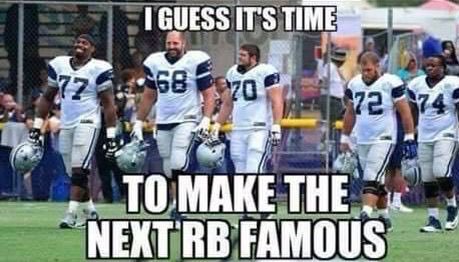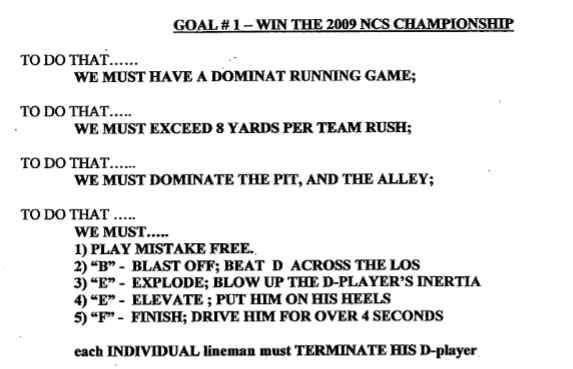Every offense uses the stalk block as a key element of their perimeter blocking strategy.
I believe that no matter how you use it, there are basic techniques and strategies to teaching the stalk blocking skills and schemes that will make your offense more dangerous.
Ultimately a great perimeter run game will also protect your interior run game.
Before we begin, a key point is that you as a coach must first address the importance of blocking at every position and a lack of effort when blocking WILL lead to a reduction in playing time.
Receivers do not dream about making big blocks, but in every level of football, a receiver is going to block on more plays than they will touch the ball.
A receiver can have a much bigger impact on a team blocking than just catching a couple balls per game.
BASIC STALK BLOCK TECHNIQUE AND TEACHING METHOD
When we begin each season, we start with the basics of 1-on-1 stalk-blocking, in a situation that most resembles a split-end blocking a corner.
We teach all of the players the same basic technique, and then begin to move toward positional or situational adjustments that stem from the basics.
But the basics are the basics, because the majority of the initial skills are used no matter how or who you are blocking.
Teaching perimeter blocking as a three-step process is what we have found to have the most impact.
This works for us in all situations, including bubbles, outside zone, sweeps and options.
STEP 1: STALK BLOCK TECHNIQUE
- Attack with a Go-Stem. We believe aggressively attacking the defender, especially a defensive back, will make him back-pedal. We explain to the kids how much easier it will be for the ball-carrier to turn the corner with you blocking the defender at eight yards, as opposed to him blocking at two yards.
- Attack the inside hip of the defender. Most college receiver coaches with whom I have spoken teach to attack the outside shoulder. For our purposes, we teach the opposite. We attack the inside shoulder of the defender, as we have found that if a receiver gets beat by an inside spike, he cannot recover. But, if we get beat outside, we are able to shuffle and recover with losing yards on the play.
- Once the defender breaks down (or you know he knows it is not a pass play), we must break down. This enables us to stop our forward momentum, widen our feet outside of our shoulders, and be prepared to move sideways while being physical.
STEP 2: STALK BLOCK TECHNIQUE
- Once we break down, we will NOT move forward, even an inch. We have found that if there is any forward momentum, we will lean, and get beat by the defender by either being pulled forward or juked because we were unable to move laterally due to our forward lean.
- We must keep our hands inside the framework of the defender’s body, and our hips on the inside hip of the defender. You notice I said nothing about our head. If you stalk-block with your head, you may get one great shot on the defender, but when separation occurs, he will be in a better position to defeat the block. But, if you stay in front of him, similar to how you play defense in basketball, you are more likely to win the block. Concerning the hip piece, this is stated to focus on not using the head but instead using the hips. We also want to make sure we are moving our feet and keeping our hips on his inside leg.
- Our hands must be inside, on the chest of the defender. In Ohio, it seems as if officials are looking for two things. The first is the location of the hands, and the second is if the defender is able to move back to create separation. If either of those even seems like it may be happening, a flag is thrown. If you can teach them to get their elbows inside of their hands, on the breastplate of the defender, you can actually grab them and not get called for a holding penalty. To ensure we do not get called for not allowing the defender to separate, we talk about letting go when they pull back and then begin the process all over again. Any time there is separation, you must go back to step 1, and go through the process, again.
STEP 3: STALK BLOCK TECHNIQUE
- The final piece is what to do after contact. It is so important to know what to do after contact because human nature is to stop your feet when you collide with another player. The receivers need to be aware of this and told that the first person that moves their feet after contact is going to ultimately win the play. Just simply explaining this fact to the kids gives us the advantage after contact, because most defensive coaches do not discuss this with their defensive backs.
CROSS BLOCKING STALK BLOCK SCHEME
If you become a team that runs a wide bubble, I would suggest adding a wrinkle into your stalk blocking scheme to prohibit teams from putting defenders outside of your #2 receiver. When we get this look, we cross-block or X-block, which gives us a great advantage. It creates a seam, similar to what a power play with a down and kick block generates. It creates a gap that the bubble receiver can run through, as opposed to weaving his way through the traffic of blockers when you are blocking the defender over the top of you.
We allow the receivers to determine if they are going to cross-block or block the defender in front of them (Figure 2). This may seem strange at first, but the more you run the bubble, the crazier looks you will get, and you must be prepared for everything. Otherwise, you will find yourself in a situation where you are unable to throw the bubble, and a big piece of your offense will be taken away.
When cross blocking, the process is taught as follows:
OUTSIDE RECEIVER CROSS-BLOCKING
Teaching the concept must begin with the release. The receiver must take what we call a narrow release, which results in running directly down the LOS. The reason for this is if the receiver stems toward where the defender is or where he thinks the defender will be, the receiver will not be able to redirect and block him if he attacks the LOS. But if the receiver takes the narrow release, he is able to redirect upfield and still wall-off the #2 defender from getting outside of him.
One new piece of this we will have to do a better job of discussing is how violent the block can be. There are new rules on crack-back blocks that officials will call if the block seems too violent. Our goal is to try to get in the defender’s way, and make him go underneath you. This makes him have to chase the defender by going around you, as opposed to going over the top of you which will allow him to more quickly get to the ball carrier.
INSIDE RECEIVER CROSS-BLOCKING
This is very simple for the #2 receiver, because not only does he get to use the basic stalk block technique, but it also creates a matchup in which he will be blocking a much weaker run defender than he is accustomed to blocking. He will loop underneath the stem of the #1 receiver, and follow the basic technique discussed above.
One area of concern that teams have tried and were successful at using, was when we cross-blocked, they would take their corner and crack-replace, putting him very close to the line of scrimmage in a very aggressive position. This also put him in a position in which they could squeeze the width of the field, which is not good for the bubble. The only thing that has worked, is when we see this happening, we sprint at the line of scrimmage side of the defender, and try to take his head off. This either creates a knock-down or at least gets the defender off-balance enough to potentially allow the ball carrier to get the edge. It is very important to practice this, as most defensive backs are taught to crack-replace at a young age. Another way to stop this from happening is to add protection to the play through pass concepts.
PASS CONCEPTS TO COUNTER AGGRESSIVE PERIMETER DEFENDERS
BUBBLE-GO PASS CONCEPT
This seems like a situation in which one pass concept would suffice, but if you’re going to use it, you actually need to have two options for the players to use. The reason for this is due to the fact that the receivers get to choose to either cross or block straight ahead, you must have two pass concepts to mirror those. You can either call them, or if you are one that allows the receivers to choose the blocking scheme, you can also allow them to choose the passing play (Figure 3 & Figure 4). This creates less issue for the QB than you think, due to the fact that we teach the receivers to get to the 4-Verts landmarks. A QB (and I ask them every year with the same answer) has yet to tell me that he is impacted by the choice of the receivers, because again, he knows one receiver will be on each of the field side 4-Verts landmarks, so the read is something he does numerous times every day during practice. The only difference is that he must first eye the bubble to help the receivers set up the double-move.
BUBBLE-SLANT PASS CONCEPT
Another idea that has the same two-concept option, is the Bubble-Slant Concept. Depending upon how you are blocking the route must be how you are running the concept, otherwise, nobody will be fooled, and you will be guaranteed to get back-pedaling defensive backs, no matter how well your body language sells the block.
BASIC CONCEPT
When running the basic concept, have the inside receiver attack the outside shoulder of the defender, as this will look as if you are putting your body in between him like a stalk block and the outside leverage he is coached to keep. You will release with a wide base and hands in a blocking position, and when he attacks the line of scrimmage, you are slanting, attacking green grass (Figure 5).
CROSSING CONCEPT
If you are cross-blocking the bubble, and therefore running the cross-blocking bubble slant concept, have the #1 receiver begin with a wide-based stalk block stem and show hands. When the defender takes his eyes off of you, you are then able to get upfield, searching for green grass (Figure 6). On both of these slant concepts, you must discuss when to continue on a regular slant path, and when to get directly upfield. It all depends on the location of the third-level defender(s).
One important point when teaching the pass concepts is to have the receivers study film of their own stalk blocking. The closer their releases are on pass plays to what they look like when they are stalk-blocking, the better the salesmanship, and therefore the higher probability the defenders bite on the fake.
If you are a team that is going to attack the perimeter and wants to become good at the stalk block in ANY fashion, you must be prepared to get Cover 1 & Cover 3, and have pass concepts for each. Your exceptional blocking will force them to play 3-over-3, which forces them into one of those two coverages. It is difficult to beat man-coverage in high school unless you practice it, and help your kids by having concepts that will beat those coverages. A basic rule of thumb for having man-beaters in your playbook is to have either double moves, or routes that run away from defenders.
CONCLUSION
In conclusion, perimeter blocking has had an enormous impact on our offenses over the years, and on the occasion when our skills are worse, it always impacts us more than we could have ever imagined. Set this Bubble Screen and alternatives up as an important aspect of your offense, and you will find the positives are only limited by your creativity and create an identity among your receivers that becomes a culture-changer.
NEXT STEPS
Finding good resources on Wide Receiver Drills is tough – I have pretty high standards. But here’s a great deal on training from four great D1 Coaches:
VIRTUAL CAMP – RECEIVERS





